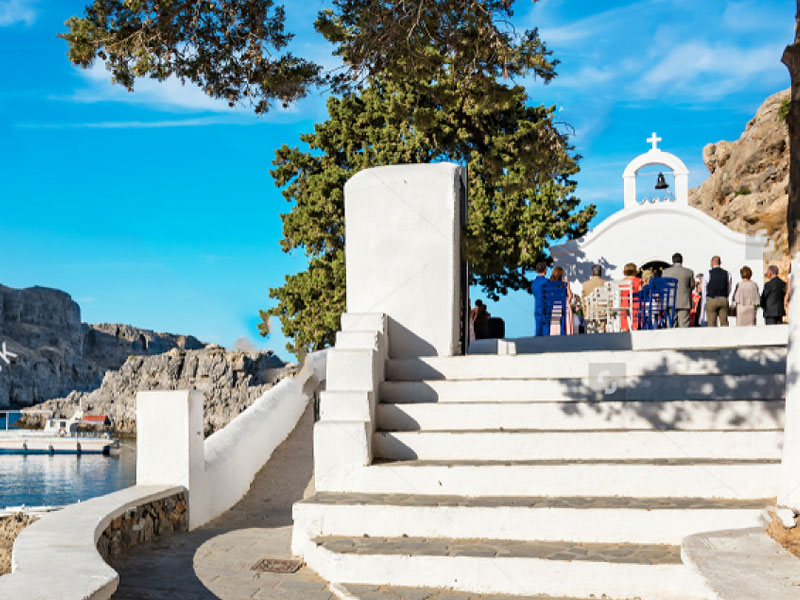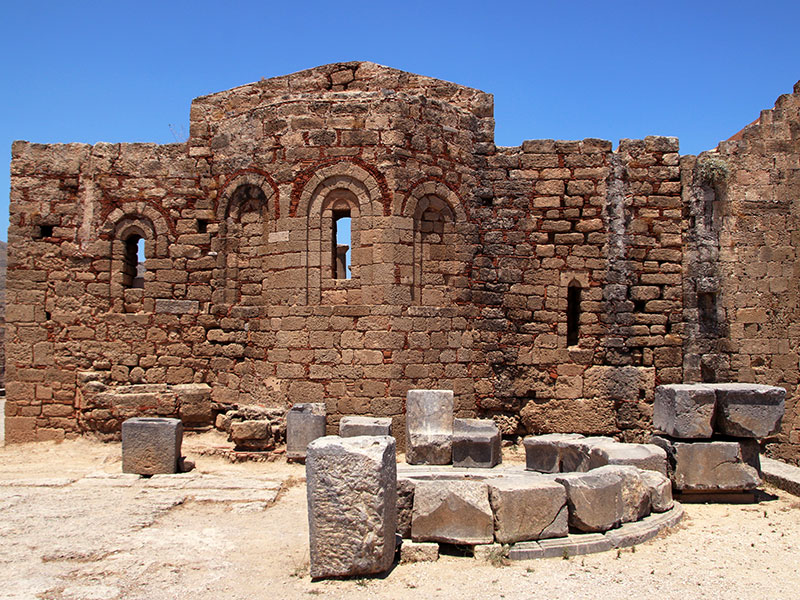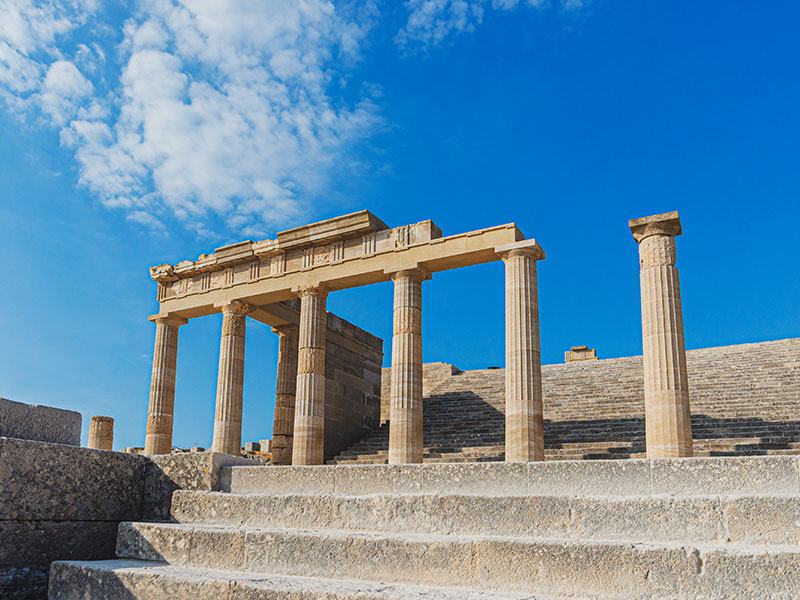Lindos Acropolis Skip the Line Tickets
- Opening Hours: Everyday 08:00-20:00.
- Entrance is available between 15 minutes before to 60 minutes after the time of have selected.
- Cancellation or rescheduling is possible until 23:59 on the day before your visit.
- Instant ticket delivery
- Smartphone Tickets Accepted
- Skip the line and show your smartphone Lindos Acropolis tickets at the entrance.
- Provider:Tiqets.
A spectacular archeological site in the heart of Rhodes Island. Relieve the glory of the past, saving time and energy with Acropolis of Lindos skip the line tickets.
For most travelers, the Acropolis of Lindos is Lindos' most spectacular archaeological site. The beautiful character of the contemporary village adds to the spectacular natural environment, with the Acropolis of Lindos standing dominantly on a high cliff at 116 m height like a sovereign platform overlooking the sea, framed by massive castle walls.
While the Acropolis of Lindos contains the most significant ancient structures, fascinating ruins may be seen across the city and just outside of it.The remains of the goddess Athena Lindia, temples from the 4th century BC, as well as the Propylaea, the huge Hellenistic Stoa, and the Byzantine church of Saint John, are located on the top of the Lindos Acropolis.
During the reign of the Knights of St. John, the castle is encircled by stronger fortress walls, and Lindos flourishes as a maritime force until the nineteenth century.

A myth surrounds the place
The worship of Athena Lindia was pre-Hellenic, according to myth, although the occasional excavation findings do not support this. The sanctuary's history starts with the Geometric era (9th c. BC). Kleoboulos, the tyrant of Lindos during the Archaoc era, resurrected the worship and erected a temple, most likely on the site of an earlier one. The Archaic temple followed the same Doric tetrastyle amphiprostyle pattern as the next one.
According to the myth, the tyrant Kleoboulos was punished by being turned into a rock for disrespecting Athena Lindia. This myth is still alive among the people of Lindos and it is believed that the rock Kleoboulos was transformed into can be found at the entrance to the Acropolis.
Another key feature of the Acropolis of Lindos is the abundance of ancient artifacts that have been unearthed over the centuries.
During the 19th century, excavations at the site uncovered a variety of objects, from votive offerings to everyday household items. The most significant of these artifacts include a large bronze statue of Athena Lindia and a marble head of the goddess Hera. These treasures provide a glimpse into the long history of the Acropolis and the many cultures that have influenced its development.
A rugged flight of stairs led up to the sanctuary. After it was destroyed by fire in 342 BC, the current temple was constructed, complete with the Propylaea and the massive stairway. The Hellenistic stoa is a later addition. The worship of Zeus Polieus was established in the third century BC, but Athena remained the sanctuary's primary goddess. During the Roman era, the priest Aglochartos planted olive trees on the site, and an inscription claims that the Sanctuary of Psithyros was constructed near the Temple of Athena (2nd c. AD).
Frequently Asked Questions about Lindos Acropolis
1. What is the Acropolis of Lindos, and why is it significant?
The Acropolis of Lindos is an ancient archaeological site located in the village of Lindos on Rhodes Island, Greece. It is known for its rich history, dating back to the 10th century BC, and its stunning views of the surrounding coastline. The site features a mix of ancient ruins, including the Temple of Athena Lindia, a Hellenistic stoa, and a Byzantine church, as well as remnants of the Knights' period fortifications.
2. How do I get to the Acropolis of Lindos?
The Acropolis of Lindos is easily accessible from the village of Lindos. You can reach Lindos by car, taxi, or public transportation (bus) from Rhodes Town or other parts of the island. Once you arrive in Lindos, you can either walk up the hill to the Acropolis (approximately 20-30 minutes) or take a donkey ride, which is available at the entrance of the village.
3. What are the opening hours of the Acropolis of Lindos?
The Acropolis of Lindos is open daily from 8:00 AM to 8:00 PM during the summer months (April to October) and from 8:30 AM to 3:30 PM during the winter months (November to March). Please note that these hours may be subject to change, so it's advisable to check the official website or contact the site directly before planning your visit.
4 .Can I take photos at the Acropolis of Lindos?
Yes, visitors are permitted to take photographs at the Acropolis of Lindos for personal use. However, the use of tripods, selfie sticks, and professional photography equipment may be restricted or require a special permit. Please respect the site's rules and avoid touching or climbing on the ancient structures to help preserve their integrity.
5. Are there any nearby attractions worth visiting while I'm in Lindos?
Yes, there are several attractions in and around Lindos that you may want to explore during your visit. These include the picturesque village of Lindos itself, which is known for its traditional white houses, narrow streets, and vibrant atmosphere. Additionally, you can visit St. Paul's Bay, a beautiful beach with crystal-clear waters, located just a short walk from the village. Other nearby attractions include the Valley of the Butterflies, Seven Springs, and Tsambika Beach.
6. Is the Acropolis of Lindos wheelchair accessible?
Unfortunately, due to the uneven terrain and steep steps leading up to the Acropolis, it is not considered wheelchair accessible. Visitors with mobility issues may find it challenging to reach the site and navigate its pathways.
7. Are there any facilities or amenities at the Acropolis of Lindos?
There are no restrooms, food, or drink facilities available on the Acropolis itself. However, you can find plenty of restaurants, cafes, and shops in the village of Lindos, where you can grab a bite to eat or purchase souvenirs before or after your visit to the Acropolis.
8 How long does it take to explore the entire Acropolis of Lindos?
The time needed to explore the entire Acropolis of Lindos may vary for each individual, but on average, it takes approximately one to two hours. However, if you plan to visit other nearby attractions or take a leisurely walk around the village of Lindos, you may want to allocate more time
9. Is there a best time of year to visit the Acropolis of Lindos?
The best time to visit the Acropolis of Lindos is during the spring (April to June) and autumn (September to October) months. During these periods, the weather is generally pleasant, and the site is less crowded compared to the peak summer season.
10. What should I wear when visiting the Acropolis of Lindos?
Given the Acropolis's location atop a steep hill, it's recommended to wear comfortable shoes suitable for walking on uneven surfaces. As the site offers little shade, consider wearing a hat and sunscreen to protect yourself from the sun.
11. Are guided tours available at the Acropolis of Lindos?
Yes, guided tours are available and can provide valuable insights about the site's history and architecture. It's advisable to book in advance during peak tourist seasons.
12. Can I bring my pet to the Acropolis of Lindos?
Unfortunately, pets are not allowed within the archaeological site for preservation purposes and the comfort of all visitors.
13. What other activities can I do in Lindos village?
Apart from visiting the Acropolis, Lindos offers a variety of activities such as exploring the traditional white-washed houses, visiting local shops for unique souvenirs, and enjoying authentic Greek cuisine at local tavernas. There are also beautiful beaches nearby for relaxation or water sports.
Historic Trivia about Acropolis of Lindos
1. When was the Acropolis of Lindos built, and who commissioned its construction?
The Acropolis of Lindos dates back to the 10th century BC when the Dorians founded the city of Lindos. The most prominent structure within the Acropolis, the Temple of Athena Lindia, was initially built in the 6th century BC under the rule of Cleobulus, one of the Seven Sages of Greece. The temple was dedicated to Athena Lindia, the patron goddess of Lindos, as a place of worship and a symbol of the city's power and prosperity.
2. What is the architectural style of the Acropolis of Lindos?
The Acropolis of Lindos features a mix of architectural styles, reflecting the various historical periods it has witnessed. The primary structure, the Temple of Athena Lindia, is designed in the Doric architectural style, which was popular during the Archaic and Classical periods in ancient Greece. The site also contains remnants of Hellenistic, Byzantine, and medieval architecture, reflecting the different cultures that have influenced the region over time.
3. Were there any significant battles or events that took place at the Acropolis of Lindos?
Yes, the Acropolis of Lindos has been involved in several important historical events and battles. In 305 BC, during the Siege of Rhodes, the Acropolis of Lindos played a crucial role in defending the island against Demetrius Poliorcetes, a Macedonian general. Additionally, during the Byzantine period, the Acropolis served as a strategic fortress and was later occupied by the Knights Hospitaller in the 14th century AD, who added further fortifications to the site.
4. Has the Acropolis of Lindos undergone any major renovations or expansions throughout history?
The Acropolis of Lindos has experienced several changes, renovations, and expansions over the centuries. The Temple of Athena Lindia was rebuilt in the 4th century BC after being destroyed by fire, and the Hellenistic stoa was added around the same time. During the rule of the Knights Hospitaller, the site was further fortified with the addition of massive walls and towers. In more recent times, archaeological excavations and restoration efforts have been carried out to preserve and maintain the site for future generations.
5. What unique features distinguish the Acropolis of Lindos from other ancient sites?
The Acropolis of Lindos is unique due to its stunning location atop a cliff overlooking the Mediterranean Sea, offering breathtaking views of the surrounding coastline. The fusion of architectural styles within the site, from Doric to Byzantine, reflects the diverse cultural influences that have shaped the history of Lindos. Another distinctive feature of the Acropolis is the ancient trireme (warship) carved into the rock at the foot of the hill, believed to be a votive offering to Athena Lindia.
6. Can you name any key figures associated with the history of the Acropolis of Lindos?
Cleobulus, one of the Seven Sages of Greece and ruler of Lindos in the 6th century BC, is closely associated with the Acropolis of Lindos, as he commissioned the construction of the Temple of Athena Lindia. Other notable figures include the sculptor Chares of Lindos, who created the Colossus of Rhodes, one of the Seven Wonders of the Ancient World, and the historian Timachidas of Lindos, who wrote about the history and culture of the region.
Lindos Acropolis Historical Timeline
6th century BCLindos Founded
The city of Lindos is founded by the Dorians, and the construction of the Acropolis of Lindos begins6th century BCConstruction of Athena Lindia
Cleobulus, one of the Seven Sages of Greece and ruler of Lindos, commissions the construction of the Temple of Athena Lindia within the Acropolis.4th century BC:Rebuild of the Temple
The Temple of Athena Lindia is rebuilt after being destroyed by fire. Around the same time, the Hellenistic stoa is added to the Acropolis.305 BCSiege of Rhodes
The Siege of Rhodes takes place, with the Acropolis of Lindos playing a crucial role in defending the island against Demetrius Poliorcetes, a Macedonian general.1st century BCThe Ancient Trireme
The ancient trireme (warship) carving is created at the foot of the hill on which the Acropolis of Lindos stands, believed to be a votive offering to Athena Lindia.Byzantine period (330-1204 AD)Byzantine Church
The Acropolis of Lindos serves as a strategic fortress during Byzantine rule. The site undergoes various modifications and additions, including the construction of a Byzantine church14th century ADKnights Hospitallers
The Knights Hospitaller occupy the Acropolis of Lindos, adding further fortifications, such as massive walls and towers.19th century ADExcavations
Archaeological excavations begin at the Acropolis of Lindos, leading to significant discoveries and a greater understanding of the site's history.20th century ADRestoration
Restoration and preservation efforts are carried out at the Acropolis of Lindos to maintain the site for future generations. The Acropolis becomes a popular tourist attraction on Rhodes Island.1994UNESCO World Heritage
The Acropolis of Lindos is included as part of the UNESCO World Heritage nomination for the Medieval City of Rhodes, recognizing its historical significance and cultural valueTodayTourist Attraction
The Acropolis of Lindos continues to be a major tourist attraction, offering visitors a glimpse into the rich history and architectural prowess of ancient Greece. Ongoing restoration and preservation efforts ensure the site remains a valuable cultural treasure for future generations
Curated Content about Lindos by










